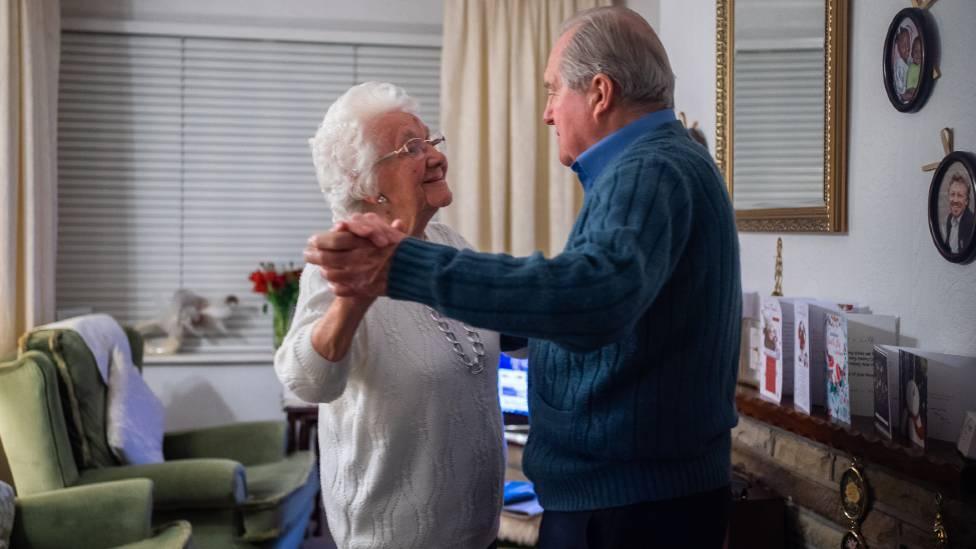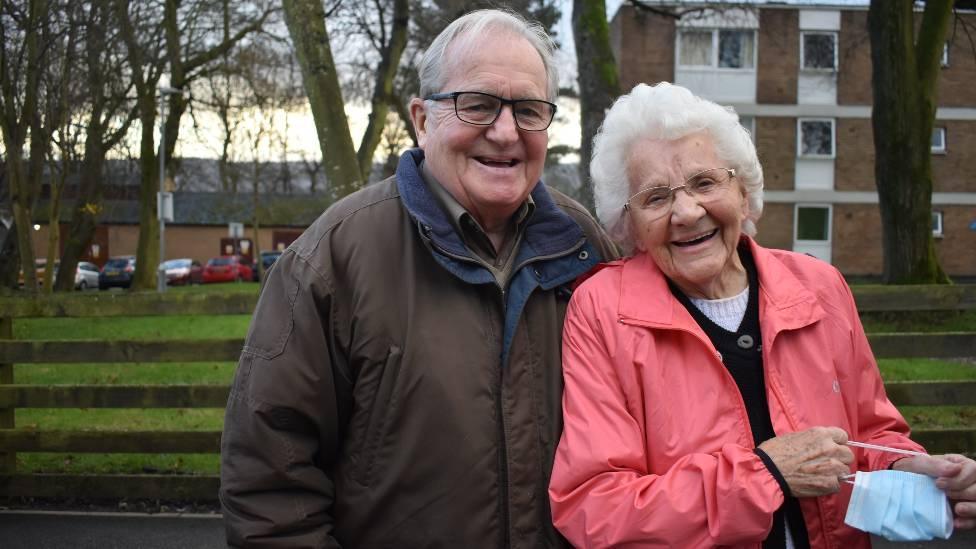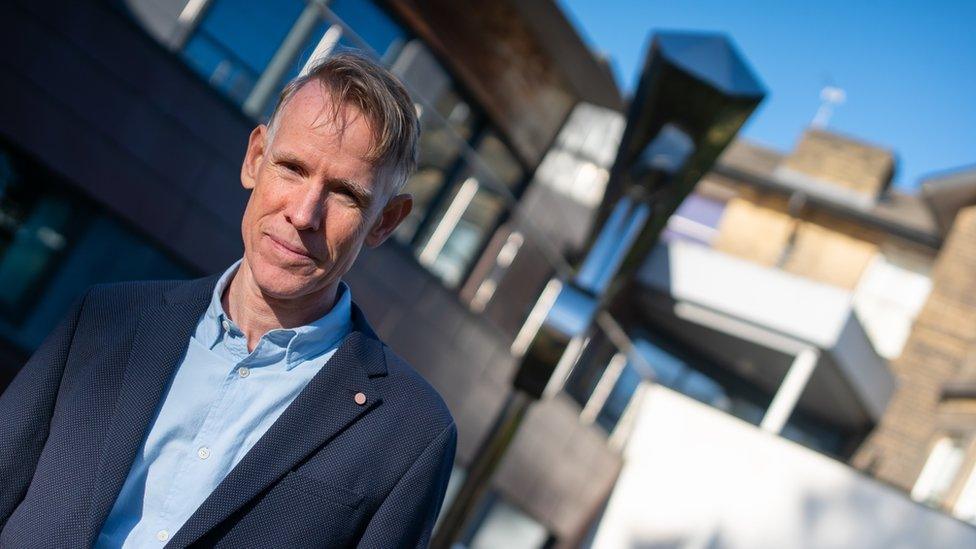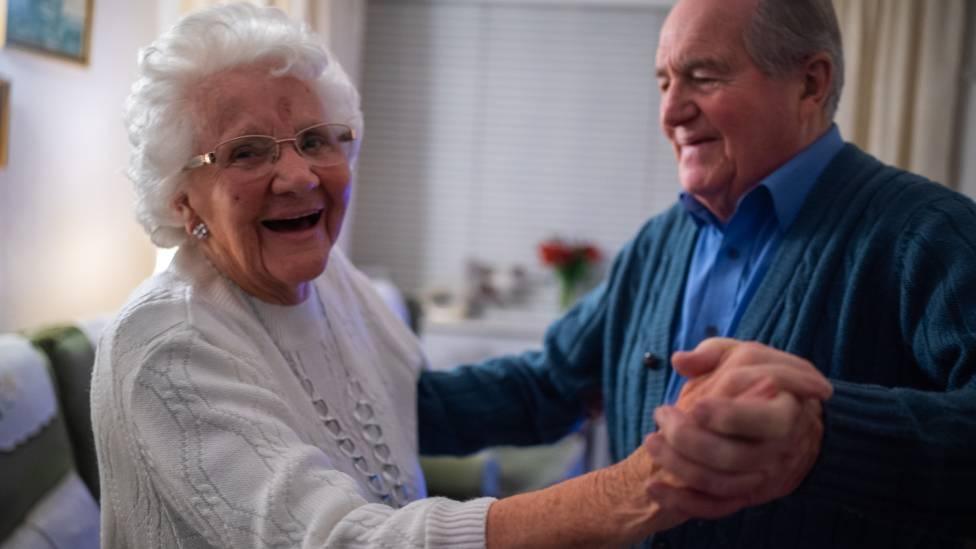Coronavirus doctor's diary: 'We turned 90, moved in together - then got the vaccine'
- Published

The UK's Covid vaccination programme has begun, with the over-80s and some health and care staff first in line. Two dancing partners who only became a co-habiting couple at the age of 90 were among the first in the queue in Bradford, where Dr John Wright of Bradford Royal Infirmary got to hear about them.
As with so many great romances, it all started for Lily Abbot and Trevor Hirst on the dance floor. They first met through Bradford's sequence dancing circuit 30 years ago, became good friends and would travel to events around the country together - Lily partnered by her husband, Wilf, Trevor with his wife, Rita.
Trevor gave up after Rita died six years ago. But eventually friends persuaded him to give it another try. And whenever he turned up at the church hall, Lily would be there. She'd lost Wilf in 2006 after 55 years of marriage.
"I'd get her up to dance," says Trevor, "and all the rest is history."

At the start of 2020, the year they both turned 90 - Lily, who is six days older than Trevor, calls him her "toy boy" - they were still living separately. "Some of our friends said, 'Why don't you two get married?'" she says.
"I said: 'We don't want to get married, we've both been married, we don't need to be married, we're all right.'" Trevor has four grown-up children, Lily has two. Both are grandparents and Trevor is a great-grandparent.
Then Covid arrived. "We didn't realise the seriousness of it at first but it's been horrendous," says Lily. One day early on in lockdown, she and Trevor went out for a walk together and Lily fell and cracked a rib.
"Trevor said he'd come and live here because both my children and his wanted us to do that - I was frightened by my fall and he came here and I said, 'You might as well stay, rather than go home at night,'" says Lily. Now they are "living over the brush", as Lily puts it. "It's just worked out great and we are so compatible."

The race to develop a vaccine has been won, though there are still plenty of runners and riders racing around the track. Now the race to vaccinate the population is firmly under way.
In Bradford we have set up four vaccine hubs across the city, one at Bradford Royal Infirmary and three in primary care.
Lily and Trevor were two of our first happy customers.
We know that we will need to vaccinate around 70% of the population to reach herd immunity to stop the chain of viral transmission. That will take many months and so the initial priority is to protect the most vulnerable.

Front-line diary

Prof John Wright, a doctor and epidemiologist, is head of the Bradford Institute for Health Research, and a veteran of cholera, HIV and Ebola epidemics in sub-Saharan Africa. He is writing this diary for BBC News and recording from the hospital wards for BBC Radio.
Listen to The NHS Front Line on BBC Sounds and the BBC World Service
Or read the previous online diary entry: 'Have I got Covid for a second time?'

Age is by far the biggest predictor of severity of disease and death, so the vaccine strategy is focused on the over-80-year-olds to start with, moving then to over-70s and so on. Care home and healthcare staff are also important as they are much more likely to catch the infection and then spread it to their residents or patients.
In the hospital we have been getting our weekly delivery of one tray or "pizza box" of 195 Pfizer vaccine vials every week. The national guidance recommended five doses per vial, allowing us to vaccinate 975 people every week. However, this is precious stuff, and it is quite possible to squeeze a sixth dose from the vials, increasing our coverage to 1,170 people every week. From next week we will ramp up to two trays and 2,340 vaccines per week.
Every day our carefully choreographed vaccine hub receives the over-80s, care home workers and frontline staff. There are always some no shows, so hanging around at the end of the day for any leftover vaccine is a good strategy for staff in the hospital.

Queuing for her Covid vaccination brought back memories for Lily, who has lived in Bradford all her life.
She was born in Undercliffe and her parents worked in the mills. "Bradford was wonderful in those days, the mills and the shops," she says. "We didn't have a lot but it was good." Hers was a large extended family - she had nine sisters and a brother.
"I see some similarities with the Asian families now as they have a similar thing with many relatives together," she says.
After leaving school at 14 she took a job as a machinist. It was at work that she met Wilf, a tailor's cutter.
Lily remembers Bradford's 1962 smallpox outbreak, which led to more than 200,000 people in the city being vaccinated against the disease. "It was awful at the time but the vaccine cleared it up," she says.
"Having the vaccine now reminds me of that. I think people who won't go and get the vaccine are foolish, it's not fair if they don't get it but it's a personal choice."

Trevor, who worked as a wool sorter in Bradford's mills, remembers getting his smallpox vaccine, too. But he preferred the 2020 experience.
"This time round we queued with some of the others from our dancing groups and that was much more fun - we were all so excited, as it means we will be soon together again," he says.
Lily is also crossing her fingers that the vaccine will allow them all to get together and dance. "We are hoping that dancing will start up again, we will all be learners, having to learn again!" she says.
Sadly, that may not be possible for a while, even if all the dancers in the groups get vaccinated quickly.

When someone is infected with SARS-CoV-2 they develop antibodies of one type (IgG) in their blood, and antibodies of a different type (IgA) in the mucosal membranes of their nose and throat.
Vaccines administered into the arm tend to be very good at protecting us from illness, thanks to the antibodies in the blood, but may not stop transmission of the virus - for this you also need the antibodies in the nose and throat. So even after their second injection, we can't be sure that Lily and Trevor will not catch and pass on the virus to others.
With the flu vaccine there is also a tendency for immunity in older people not to last a long time, and it's likely the same will be true with this vaccine. Furthermore, some of the dancers may be among the 5% of recipients not protected by the vaccine (though we hope it will reduce symptoms).
I am confident that Lily and Trevor will get back on their dancing feet as herd immunity eclipses the virus and eases it out from our daily lives.
After that, I am quietly hoping to see them on Strictly.
Follow @docjohnwright, external and radio producer @SueM1tchell, external on Twitter

SOCIAL DISTANCING: What are the rules now?
FACE MASKS: When do I need to wear one?
TESTING: What tests are available?
LOOK-UP TOOL: How many cases in your area?
